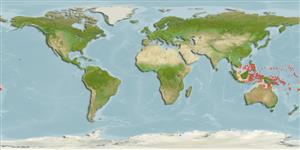Classification / Names
Common names from other countries
Main reference
Size / Weight / Age
Max length : 2.1 cm SL male/unsexed; (Ref. 46956)
Environment
Marine; reef-associated; depth range 3 - 30 m (Ref. 46956)
Climate / Range
Tropical; 22°C - 25°C (Ref. 27115), preferred ?; 14°N - 18°S
Distribution
Short description
Dorsal
spines
(total): 7;
Dorsal
soft rays
(total): 8;
Anal
spines: 1;
Anal
soft rays: 7. This species belongs to the cephalic sensory-pore group 2 with the following characters: lacking only the IT pore, has simple pectoral-fin rays, a dorsal/anal fin-ray formula almost always 8/7, and with the 5th pelvic-fin ray longer than 30% of the length of the 4th ray; however, its abdomen is not black. It is most easily confused with E. prasites and E. spilota (Ref. 89418).
IUCN Red List Status (Ref. 115185)
Threat to humans
Harmless
Human uses
Aquarium: commercial
More information
Common namesSynonymsMetabolismPredatorsEcotoxicologyReproductionMaturitySpawningFecundityEggsEgg development
ReferencesAquacultureAquaculture profileStrainsGeneticsAllele frequenciesHeritabilityDiseasesProcessingMass conversion
Tools
Special reports
Download XML
Internet sources
Estimates of some properties based on models
Phylogenetic diversity index
PD50 = 0.5000 many relatives (e.g. carps) 0.5 - 2.0 few relatives (e.g. lungfishes)
Trophic Level
3.1 ±0.3 se; Based on size and trophs of closest relatives
Resilience
High, minimum population doubling time less than 15 months (Preliminary K or Fecundity.)
Vulnerability
Low vulnerability (10 of 100)
Price category
